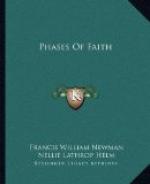The question also arose, whether Peter’s testimony to the transfiguration (2 Pet. i. 18), was an important support. A first objection might be drawn from the sleep ascribed to the three disciples in the gospels; if the narrative were at all trustworthy. But a second and greater difficulty arises in the doubtful authenticity of the second Epistle of Peter.
Neander positively decides against that epistle. Among many reasons, the similarity of its second chapter to the Epistle of Jude is a cardinal fact. Jude is supposed to be original; yet his allusions show him to be post-apostolic. If so, the second Epistle of Peter is clearly spurious.—Whether this was certain, I could not make up my mind: but it was manifest that where such doubts may be honestly entertained, no basis exists to found a belief of a great and significant miracle.
On the other hand, both the Transfiguration itself, and the fiery destruction of Heaven and Earth prophesied in the third chapter of this epistle, are open to objections so serious, as mythical imaginations, that the name of Peter will hardly guarantee them to those with whom the general evidence for the miracles in the gospels has thoroughly broken down.
On the whole, one thing only was clear concerning Peter’s faith;—that he, like Paul, was satisfied with a kind of evidence for the resurrection of Jesus which fell exceedingly short of the demands of modern logic: and that it is absurd in us to believe, barely because they believed.
[Footnote 1: Matt. xii. 39, xvi. 4.]
[Footnote 2: John xx. 29.]
[Footnote 3: John xiv, 11. In x. 37, 38, the same idea seems to be intended. So xv. 24.]
[Footnote 4: A reviewer erroneously treats this as inculcating a denial of the possibility of inward revelation. It merely says, that some answer in needed to these questions; and none in given. We can make out (in my opinion) that dreams and inward impressions were the form of suggestion trusted to; but we do not learn what precautions were used against foolish credulity.]
[Footnote 5: If miracles were vouchsafed on the scale of a new sense, it is of course conceivable that they would reveal new masses of fact, tending to modify our moral judgments of particular actions: but nothing of this can be made out in Judaism or Christianity.]
[Footnote 6: A friendly reviewer derides this passage as a very feeble objection to the doctrine of the Absolute Moral perfections of Jesus. It in here rather feebly stated, because at that period I had not fully worked out the thought. He seems to have forgotten that I am narrating.]




